Married with Children: Wittenberg Style
When Ex-Priest Martin Luther
Weds Ex-Nun Katherine von Bora,
A Memorable Union Ensues.
“At home I have good wine and beer and a beautiful wife,
or (shall I say) lord.”
— Martin Luther on home and his wife Katherine von Bora. (1534)
By Ronald Fritze
Posted on February 8, 2010, from Athens, Alabama
Early in the German Reformation, on April 4, 1523 (the day before Easter that year), twelve well-born Cistercian nuns escaped from their cloister at Nimbschen. With the help of Leonard Kopp, solid citizen of Torgau and supplier of foodstuffs to the monastery, they made their way to Wittenberg by 7 April. Legend has it that Kopp concealed the renegades in barrels used for storing herring, which would have been a rather smelly experience. If so, it would have been a scene reminiscent of the escape of Bilbo Baggins and the dwarves from the Elk King’s stronghold in The Hobbit.
In fact, the twelve nuns simply rode inside a covered wagon hidden from the watchful eyes of the cloister’s guardian monks.
Once they reached Wittenberg, the nuns came under the protection of Martin Luther, the leader of the Reform movement in Germany. He agreed to help them, even though the penalty for aiding runaway nuns was death under both Canon and Civil Law. Soon, some of the women rejoined their families, some became governesses, and some married.
Reluctant at First,
The Vivacious Nun Chooses Luther
One of the nuns proved to be a problem. At twenty-four years of age, Katherine von Bora was past the normal age for marriage. Being vivacious, she still managed to attract a suitor, Jerome Baumgartner, whom she also loved. But the match never came to pass because the man’s family objected to his marriage to a renegade nun. Late in 1524 efforts began to find Katherine another suitor, efforts that she firmly resisted. Then, suddenly, she stated her willingness to marry either Luther or his associate, Nicholas von Amsdorf. A hitherto confirmed bachelor, Luther agreed that at the age of forty-two, the time was right for him to wed. So on June 13, 1525, the ex-monk and the ex-nun wed.
Laughing Angels, Weeping Devils
The wedding of Martin and Katherine was not done lightly, nor was it without controversy. Luther thought long and hard about whether he should get married. Some of his friends and family supported the marriage. Hans Luther, his father, greatly desired his son to marry and produce sons. Lucas Cranach the elder and his wife Barbara were very supportive of Martin and Katherine’s marriage and attended the wedding as witnesses.
Luther’s friend and colleague Philipp Melanchthon opposed the marriage and refused to attend the ceremonies. Melanchthon and others felt that Luther’s wedding would be scandalous and harm the cause of the Reformation.
Ultimately, Luther came to the opposite conclusion. As he put it, there was “a battery of reason in favor of his proposal: his marriage would please his father, rile the pope, cause the angels to laugh and the devils to weep.”
Married life agreed with Luther, who grew to love his “Katie” dearly and fathered six children with her. His action is also a stunning testimonial to the Reformation’s position concerning marriage and celibacy for religious leaders.
No Misogyny in this Household
On some matters, Luther was very much a sixteenth-century male. He believed that the man was the head of the family and should be in charge of government as well. But unlike many of his contemporaries, he did not support the high level of misogyny that characterized the intellectual worldview of the Renaissance. Luther gave Katherine von Bora control of the family finances and the running of the household. She was more practical and grounded — not the simple housewife preferred by most men of the time.
The Luthers lived in the Black Cloister, the former home of the Augustinian monks in Wittenberg and the place where Luther had lived before the Reformation. While the other monks, one by one, began to abandon the cloistered life, Luther staked a claim on the property by making it his family home. Katherine von Bora supported her family by gardening, making wine, raising livestock, and brewing. She raised or grew most of the food that appeared on the Luthers' dinner table — and, all reports agree, Katherine von Bora was a very good cook.
A Place at the Table for All
The Luthers invited and welcomed many guests into their home. Being a former monastic residence, the Black Cloister had many small rooms, which the Luthers rented to students or visiting clergy. These visitors and guests ate at the Luther table, with every meal seemingly overflowing with hungry seekers, acolytes, and fellow rebels. Some guests were not paying customers either, which put a strain on the family resources. In effect, Katherine von Bora was running a boardinghouse to provide additional income for the family.
Luther showed his regard for his wife Katherine in other significant ways. On one occasion, he put her on a search committee to hire a new pastor. In those days it was unheard of to allow a woman to be part of such a decision. To the grumblers Luther commented that his wife would show better judgment than he would. He also let Katherine handle much of his business with publishers. Frequently, Luther also took her advice on intellectual and political matters.
Another practical display of Luther’s confidence in and care for his wife was his will, written in his own hand. It made Katherine von Bora his sole heir. In Saxony, it was common practice to make the children the heirs of a deceased male. The heirs were then expected to take care of their surviving mother. Many did not. Luther wanted his wife to be economically secure and independent in her widowhood. It was an unheard of act on Luther’s part.
The Odd Couple
Forge a Lasting Union.
The marriage of Martin Luther and Katherine von Bora initially appeared to create an odd couple. Luther was a former monk in his early forties with habits not too akin to domestic harmony. During one period of his bachelor days, he went for two years without changing the sheets on his bed. It is unclear whether that particular set of sheets was laundered or burned afterward.
Katherine came from a family of higher social rank than Luther’s, albeit an impecunious family. The Von Boras were members of the knightly class, a proud but declining segment of German society. Luther came from peasant stock. His father Hans was a miner who got involved in the business side of the mining and became well-to-do.
Initially Luther considered Katherine to be overly proud, but he quickly grew to love her. He clearly liked sleeping with his “Katie” and remarked on the joy of waking up to pigtails on the pillow next to him. The Luthers had an affectionate relationship. Luther liked to joke with his wife. In his letters he sometimes called her “my sweetheart Kate” or “my dearly beloved Kate” or “my true love.” Other references showed his respect for her intelligence when he referred to her as “Mrs. Doctor” and ”Doctora Lutherin.” Luther could also joke with Katherine by calling her “Lady of the New Pig Market,” a reference to her efforts to raise pigs to feed her family and boarders.
Dear Little Magdalene
Of the Luthers’ six children, four survived to adulthood — Hans, Martin the younger, Paul, and Margarete. Elizabeth died in 1528 before she reached eight months, a tragedy that greatly saddened the Luthers. Magdalene, the Luther’s next child, was born in 1529. Since she was another daughter, Magdalene took the place of the deceased Elizabeth for Martin and Katherine. Sadly, she died when she was only thirteen years old.
Magdalene’s death revealed the spiritual foundation of the Luthers’ life together. As the child’s illness worsened, husband and wife comforted the stricken Magdalene and each other through expressions of their faith in God’s will. As the end approached, one of Luther’s friends described how “he fell on his knees before the bed and, weeping bitterly, prayed that God might will to save her. Thus she gave up the ghost in the arms of her father. Her mother [Katherine] was in the same room, but further from the bed on account of her grief.”
Losing young children was an experience and a burden shared by many families during the sixteenth century. Still, it grieved the bereaved parents every bit as much as it would sadden a mother and father to lose a child in our day and age.
Despite these tragic losses, the Luther household was a happy one for Martin and Katherine and their children. The Luthers were strict but loving parents who allowed their children plenty of time to play.
Let's Squabble about Money.
Friends and partners they were, but both were also possessed of strong personalities, leading to occasional episodes of quarrelling, as is normal for married couples. Their biggest source of disagreement was money. Luther liked to spend it and Katie liked to save it. This observation is not to imply that Luther was a spendthrift. His monetary failing was his generosity. He allowed many who were in need to lodge at the Black Cloister as boarders without paying rent, and he willingly gave money to friends in need.
Luther's business sense as an author was also poorly developed. Publishers made handsome profits from his books while the popular author saw little to no income from his writing.
Unfortunately, historians have few sources that provide insights into the mind of Katherine von Bora. Only a few of her letters survive. Otherwise, we are dependent on how others describe her. Luther liked to tease Katherine and she gave him back as good as she got.
During one dinner table conversation, Luther remarked, “The time will come when a man will take more than one wife.”
Katherine responded, “Let the devil believe that!” to which Luther answered, “The reason, Katy, is that a woman can bear a child only once a year while her husband can beget many.”
Undismayed, Katherine cited from First Corinthians 7:2. “Paul said that each man should have his own wife.” Luther quipped back, “Yes, ‘his own wife’ and not ‘only one wife,’ for the latter isn’t what Paul wrote.”
The jesting continued for a while longer until Katherine ended the discussion when she said, “Before I put up with this [polygamy], I’d rather go back to the convent and leave you and all our children.”
'Till Death Do Us Part
Just as Luther loved his “Dear Kate,” she loved him just as deeply. After Luther’s death on 18 February 1546, Katherine wrote to her sister-in-law Christina von Bora two months later.
“I know that you take pity on me and my poor children,” Katherine wrote. “For who could not be deeply grieved and saddened
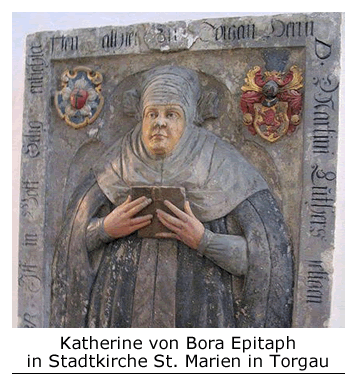 over the loss of such a dear and precious man as my husband has been. He gave so much of himself in service not only to one town or to one country, but to the whole world. Yes, my sorrow is so deep that no words can express my heartbreak, and it is humanly impossible to understand what state of mind and spirit I am in . . . I can neither eat nor drink, not even sleep . . . God knows that when I think of having lost him, I can neither talk nor write in all my suffering.”
over the loss of such a dear and precious man as my husband has been. He gave so much of himself in service not only to one town or to one country, but to the whole world. Yes, my sorrow is so deep that no words can express my heartbreak, and it is humanly impossible to understand what state of mind and spirit I am in . . . I can neither eat nor drink, not even sleep . . . God knows that when I think of having lost him, I can neither talk nor write in all my suffering.”
Katherine von Bora died on 20 December 1552 at the age of fifty-three. War in the region of Wittenberg had forced to her to flee with her family. She fell into a watery ditch while trying to control the horses pulling her family’s wagon. The cold, the damp, and possible internal injuries caused her to sicken. Deathly ill, she was taken to Torgau by her children, where she died and was buried.

|


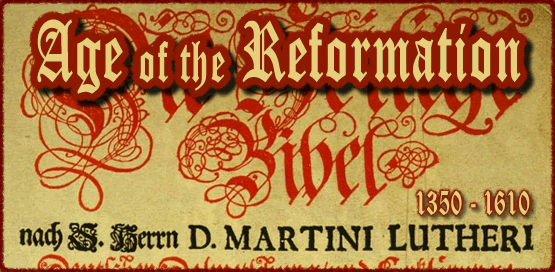


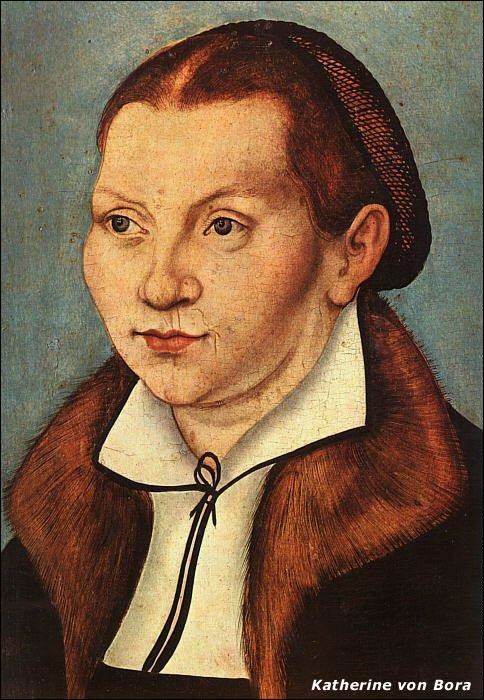

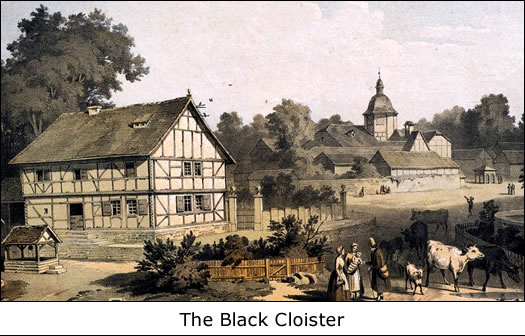

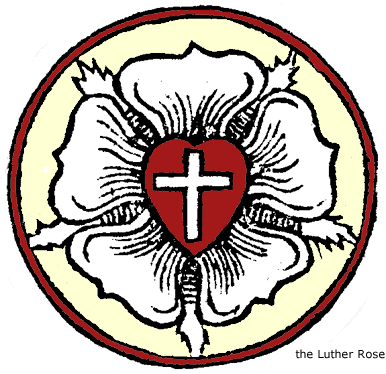
 over the loss of such a dear and precious man as my husband has been. He gave so much of himself in service not only to one town or to one country, but to the whole world. Yes, my sorrow is so deep that no words can express my heartbreak, and it is humanly impossible to understand what state of mind and spirit I am in . . . I can neither eat nor drink, not even sleep . . . God knows that when I think of having lost him, I can neither talk nor write in all my suffering.”
over the loss of such a dear and precious man as my husband has been. He gave so much of himself in service not only to one town or to one country, but to the whole world. Yes, my sorrow is so deep that no words can express my heartbreak, and it is humanly impossible to understand what state of mind and spirit I am in . . . I can neither eat nor drink, not even sleep . . . God knows that when I think of having lost him, I can neither talk nor write in all my suffering.”